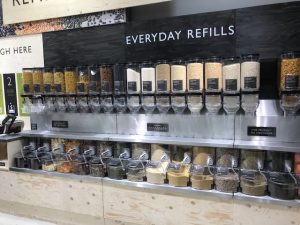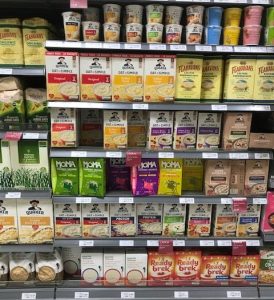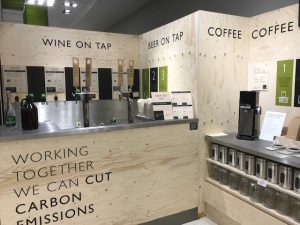Waitrose drops the plastic
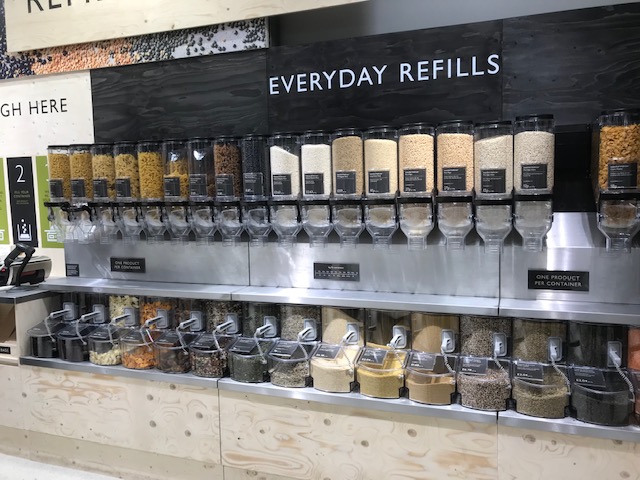
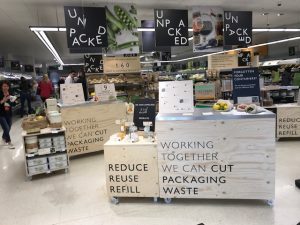 Grocery multiples are trialling different models to reduce plastic packaging across various categories around their stores. What is most notable about these trials is that, unless FMCG brands innovate within their category, they risk being eclipsed by unbranded goods, the package free, print free, plastic free alternatives made available by retailers. It’s in this future landscape that plastic-laden packaged goods could become the eyesore at retail.
Grocery multiples are trialling different models to reduce plastic packaging across various categories around their stores. What is most notable about these trials is that, unless FMCG brands innovate within their category, they risk being eclipsed by unbranded goods, the package free, print free, plastic free alternatives made available by retailers. It’s in this future landscape that plastic-laden packaged goods could become the eyesore at retail.
I’ve been privy to the internal debates within some multiple retailers’ strategic teams but in this article, I give an appraisal of some of the initiatives visible in the public domain. I conducted shopper research in a UK grocery store (Waitrose, Oxford) which is currently trialling different models to reduce plastic packaging across various categories around the store.
No challenge could be bigger than addressing the scale of plastic waste polluting land and water. 8 billion kilos of plastic end up in our oceans, every year, and much of it ultimately ends up in the food chain, from particles found in fish to the salt on the dinner table.
Big challenges inspire the most innovative thinking, obliged as we are to think differently beyond the functional aspects of our products, from how they are packaged to what happens to them when they reach the end of their useful existence.
Of the 3-pronged approach – REDUCE, RECYCLE, REUSE – RECYCLE and REUSE are important measures, but the most powerful of them all is REDUCE. The key to meeting the challenge overall begins with a reduction in production of “virgin” synthetic plastic.
 The best aspect of the Waitrose trial is the fact that it has focused so much of its effort on the removal of plastic packaging from its shelves, from cut flowers to nuts and muesli. The least convincing aspect is that in some instances it has not properly thought through the shopper process, matching the desire for speed and convenience with the means to reuse plastic containers. It has fallen for a few irritating and counterproductive gimmicks.
The best aspect of the Waitrose trial is the fact that it has focused so much of its effort on the removal of plastic packaging from its shelves, from cut flowers to nuts and muesli. The least convincing aspect is that in some instances it has not properly thought through the shopper process, matching the desire for speed and convenience with the means to reuse plastic containers. It has fallen for a few irritating and counterproductive gimmicks.
Plastic free fresh produce and cut flowers: 8/10.
Self-serve “baskets” made entirely of recyclable cardboard were easy and quick to use, to pick product and add extra portions of small fruits, to close securely, weigh, price and process at check out. For a child, the whole process of weighing and sticking the price ticket on is both educational and fun. For an adult, it’s quick and easy. The card baskets are so well made, they can even be used multiple times before they disintegrate.
For non-consumables, such as toys, unlike a display of loose tomatoes or grapes, their more precious contents need to be securely pre-packaged, sealed in, clearly identifiable by brand and product name, and with instructions, content and safety information. The fresh product baskets illustrate the potential for multiple benefits, intentional or not, in clever design and cardboard engineering, and how the process of selecting eco-friendly products can be fun and engaging for kids too.
 Not so clever were the paper bagged grapes. Whilst paper bags offer an alternative presentation of berry fruits, the bags had evidently already begun to disintegrate on the fixture and disintegrated even more when the bags were handled. It was worth trying but not pursuing.
Not so clever were the paper bagged grapes. Whilst paper bags offer an alternative presentation of berry fruits, the bags had evidently already begun to disintegrate on the fixture and disintegrated even more when the bags were handled. It was worth trying but not pursuing.
 In the weighing and pricing process, not only could shoppers take a reusable canvass bag, fill it with loose produce, weigh it and collect the price sticker, Waitrose also provided book-mark shaped cards on which to stick the price stickers, complete with bar-codes for easy scanning at the checkout.
In the weighing and pricing process, not only could shoppers take a reusable canvass bag, fill it with loose produce, weigh it and collect the price sticker, Waitrose also provided book-mark shaped cards on which to stick the price stickers, complete with bar-codes for easy scanning at the checkout.
A great idea but with definite teething problems for both staff to handle and shoppers to ensure that they don’t pay multiple times for the same item. Because the price stickers could be placed on the card so closely together, there is a high risk that checkout staff would inadvertently scan the same price ticket multiple times. This happened to several shoppers whom I was conducting research with.
Cereals, nuts, seeds and coffee: 4/10
In FMCG categories, whatever the shopper mission in store, given that we humans are driven to operate on auto pilot during a shop, speed and ease are everything – from rapid location of habitually purchased brands to the triggers which compel shoppers to conduct rapid appraisal of new arrivals.
I love the idea of a bring-your-own tub refilling station. I was willing it to win. However, the refill station was very evidently a point of congestion with shoppers having to wait patiently for their turn to access their desired product and manoeuvre their trolleys around each other awkwardly in a small space. Worse was to come. On a number of occasions, the refill dispenses emptied. Not that you could see this on the outside of the container, as you might an empty shelf, if you were a shelf stacker tasked with keeping the product flowing. Once empty, it took on average 15 minutes for staff to replace empty dispensers with full ones, adding to the time wasted and the congestion of those who were waiting.
Most of the dried goods on offer in the refill station could be pre-packed in card containers or paper bags to pre-set weights, without the need for plastics. The real advantage of anyone wanting to use the refill station is in customising the weight of fill. So, the responsibility remains on the shoulders of packaged dried goods manufacturers to supply their products in 100% biodegradable containers.
I am a fresh coffee fan. I like to make my coffee ground fresh from the beans. Sadly, I think the facility to grind beans and paper bag them at the refill counter is flawed for two reasons. Firstly, it adds to the complexity of process and congestion in the refill area. Secondly, coffee only retains its delicious taste once the beans have been ground if it’s placed in an airtime container, to seal in the aroma. My criticism comes from good intentions, a desire to make this refilling idea work and scale-able.
Drinks on tap counter: 5/10
I’m excited by the idea of a drinks on tap bar. It’s reminiscent of the wine “pump stations” found near local vineyards in France. Unfortunately, the beer and wine bought on tap at a Waitrose store are to be consumed within 2-5 days, and the choice is extremely limited.
This counter service got me thinking, however. Pubs and bars are able to stock far more extensive ranges of beers and wines on tap than in this trial store, so there is potential to expand the choice to mirror a broader range of preferences.
The biggest source of plastic pollutants, however, is not to be found in the wine and beer categories, which use glass more than they do plastic. It’s the scourge of single use plastic water and soft drinks bottles. Which brings me on to my final observation. The biggest environmental gain is in the lunch and snack fixtures with their plastic sandwich packs, plastic bottles and foil crisp wrappers. Small disposable meals in disposable packaging, not of which is biodegradable.
My challenge to Waitrose is in tackling this category. Food and drink bought in this section of the store is consumed within a short time of purchase, allowing greater flexibility on how it is packaged.
- Sandwiches which can be wrapped in biodegradable grease proof paper instead of plastic.
- Salads, salad accompaniments, yogurts and fruit pots can be counter served in bring-your-own containers.
- Cutlery for on-the-go eating are available on the market in organic biodegradable materials.
- Crisps could be portioned and served at the counter in paper bags.
- Soft drinks could be served “on draught” straight into reusable
drinks bottles, from a bar counter, not dissimilar to the one already being trialled for alcoholic beverages.
Brands can play an active role in making their presence known in these categories, even where there are refill counters. It is not inevitable that they lose brand impact but securing your brand’s impact might be on a first come first served basis. Think about all the different ways in which branding works in different channels. A beautiful pump design for branded drinks on draught, reminiscent of the designs you might see in the licensed trade. Food service menu designs, flooring around the service counter, branded dispensers.
It’s ready for the taking and it’ll make you feel good about your brand…
